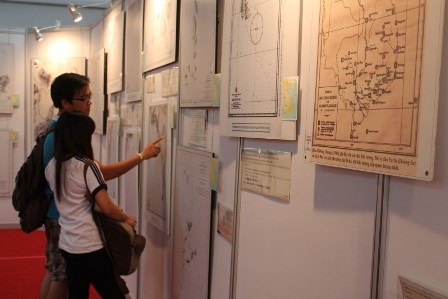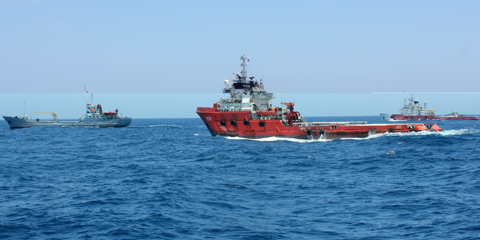Five scenarios for East Sea
There are five scenarios for the East Sea dispute in the next 10 years.
China cannot give evidence

Visitors at an exhibition of ancient maps showing Hoang Sa, Truong Sa as Vietnam's territories.
Before international law, historical evidence with legal values is the most convincing factor.
However, international law experts also said that in resolving territorial disputes, on land or on sea, the ability of the involving parties to have historical evidence with legal value is not high.
According to Nuno Sergio Marques Antunes, a Portuguese expert on international maritime disputes, "the disputes based only on legal arguments ... are relatively rare. The vast majority of the territorial disputes lack meaningful legal arguments. In most cases, the arguments without legal value stand out."
Each side in the territorial dispute must take advantage of all the evidence seriously, regardless of form, as Brian Taylor Sumner, American expert on international law has confirmed, pointing out nine different categories, including historical evidence.
China’s historical evidence on its sovereignty over Hoang Sa-Truong Sa (Paracel-Spratly Islands) based on ancient history or even on the events that happened in the past 60 years contain many mistakes, intentionally to mislead the public opinion.
While some Western scholars relied on a part or the entire Chinese ancient history to support China, Vietnam's researchers have analyzed the serious flaws in ancient history of China over its sovereignty of the Hoang Sa-Truong Sa.
In his book published in English in 2013, Wu Shicun used the following arguments to justify China’s claim on the islands in the East Sea: China discovered and named the islands of the Hoang Sa-Truong Sa Islands, China received tributes from the Vietnamese feudal government, the Democratic Republic of Vietnam acknowledged the sovereignty of China over Hoang Sa-Truong Sa, the Socialist Republic of Vietnam just inherited only from the DRV, etc.
The value of the argument
Firstly, if you think China is the country that explored or named the islands in Hoang Sa and Truong Sa Islands so it holds sovereignty over Hoang Sa-Truong Sa, then this argument does not meet the standards of international law on possession as I mentioned above.
At the same time, the argument that as the country receiving tribute from the Vietnam feudal government until 1885, then it holds sovereignty over Hoang Sa-Truong Sa, is also rejected based on historical evidence and the case between France and Britain on the Minquiers -Ecrehos region.
The argument that the Democratic Republic of Vietnam once recognized China’s sovereignty over Hoang Sa-Truong Sa and the SRV only inherited from the DRV, so China holds sovereignty over Hoang Sa-Truong Sa, is rejected, based on the adaptation of the principles of prevention (estoppel), the nation's inheritance rights under international law and historical evidence in international relations of Vietnam in the period 1954-1976.
In addition to satisfying two standards of international law before the Convention of Berlin, historical evidence about Vietnam’s sovereignty over Hoang Sa in ancient Western documents in over 200 years from the early seventeenth century to the late nineteenth century particularly satisfy criteria set forth in the 1885 Convention on the awareness of the international community to the sovereignty of Vietnam.
In contrast, until today, the Chinese cannot present any historical evidence favorable to their claims from the ancient Western sources before the twentieth century.
China refers to two events: Kuo Sung-tao, the first Chinese ambassador in England in 1876-1877 stated that Hoang Sa belongs to China, and China opposed and prevented the Germans from the survey in Hoang Sa and Truong Sa in 1883.
However, China does not have independent documentation verifying the accuracy of the claims of Kuo Sung-tao and in 1885, Germany popularized the detailed map of Hoang Sa area that they surveyed in 1881-1883.
Compared with China, the historical evidence of Vietnam over its sovereignty of Hoang Sa-Truong Sa is more clear and stronger.
The five scenarios
In late September 1975, in a meeting between leaders of the two countries, when the First Secretary of the Workers' Party of Vietnam Le Duan raised the issues of Hoang Sa-Truong Sa Islands, Chinese Vice Premier Deng Xiaoping admitted the dispute and proposed that the two countries discuss the issue later. But, after nearly 40 years, the dispute has not been resolved.
In this context, we believe that there are five scenarios for the East Sea dispute in the next 10 years:
The first scenario, China will use force to invade a part or entire Truong Sa Islands, in order to "resolve disputes and establish sovereignty over the islands and territorial waters by 2020" as Chinese scholars asserted and according to other sources.
In the marine disputes, China used force against Taiwan in the 1950s, and against Vietnam in the 1970s and 1980s.
The new military adventure of China in Truong Sa, in order to control all of the islands, rocks within the "cow tongue", will cause insecurity and instability in the East Sea, affecting maritime traffic of the U.S., Japan, India, etc.
No one was surprised with the statement that China has closely followed developments in Ukraine and Crimea to assess response and countermeasures of the U.S. and the European Union to Russia.
However, due to major differences with the annexation of the Crimea to Russia, this scenario may bring about economic, military, political, etc. results that are beyond the estimations of China's leaders.

The second scenario, China agrees to solve the dispute at international courts. Due to the weakness of China in historical and legal evidence, due to the use of force in 1974 and 1988 to occupy the islands and rocks in Vietnam’s Hoang Sa-Truong Sa, and to not have enough for the principle of "quieta non movere",China opposes legislation or internationalization of the East Sea issue, sticks to the policy of "bilateral negotiations", "setting aside dispute and pursuing joint development". More than anyone else, China understands that they will lose more than they gain if they have to face international courts.
The third scenario, China does not use force but continues the tactics of prolonging the time to solve the East Sea dispute.
Based on the principles set forth in international law, China strengthens its position on the East Sea to permanently occupy the islands that are currently under its illegal control. This is a favorable scenario for China and disadvantageous for Vietnam, if Vietnam does not use international law to resolve the disputes with China in the near future.
The fact shows that China has been successful in more than 20 years when applying the "peaceful dialogue" tactics in territorial disputes with other countries until the Philippine sued China to the Arbitration Court in accordance with the Appendix VII of UNCLOS in early 2013.
The fourth scenario, China boosts the tactics "silkworms eat mulberry" over the East Sea. They continue to exercise sovereignty in the islands of illegal occupation, turn the undisputed areas into disputed areas and force the involving countries to implement "peace dialogue" or "setting aside dispute and pursuing joint development" in the new "disputed" areas.
This scenario helps China expand the boundaries of the "cow tongue" but they cannot predict every response, including the possibility of limited military conflict with ASEAN members, with the U.S. or other allies of the U.S.
This scenario is disadvantageous for Vietnam if Vietnam does not use international law to resolve disputes with China in the near future.
The fifth scenario. China makes serious negotiations with Vietnam (and the ASEAN countries having disputes with China) to solve the East Sea dispute. This is the most favorable scenario for Vietnam and other countries, but unfavorable to the ambition of monopolizing the East Sea.
The events related to the East Sea from early 2013 until today shows that the situation does not allow Vietnam to hesitate to resolve marine dispute with China to the roots.








